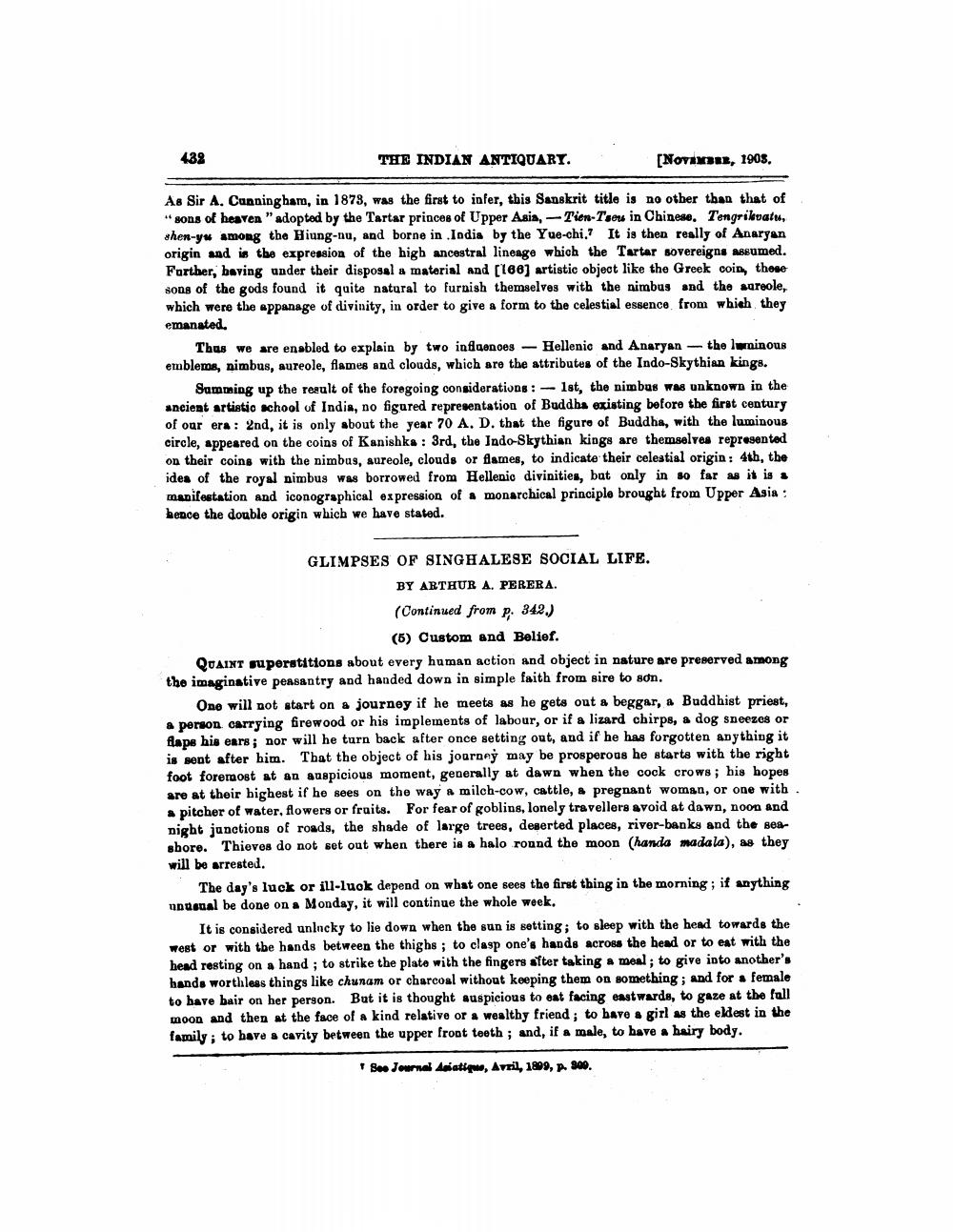________________
438
THE INDIAN ANTIQUART.
[Nova
, 1908.
As Sir A. Canningham, in 1879, was the first to infer, this Sanskrit title is no other than that of "sons of heaven "adopted by the Tartar princes of Upper Asia, - Tien-T'sen in Chinese. Tengriluatu, shen-yw among the Biung-nu, and borne in India by the Yue-chi,? It is then really of Anaryan origin and is the expression of the high ancestral lineage which the Tartar sovereigns assumed. Further, having under their disposal a material and [160) artistic object like the Greek coin, those sons of the gods found it quite natural to furnish themselves with the nimbus and the screole, which were the eppanage of divinity, in order to give a form to the celestial essence from which they emanated.
Thus we are enabled to explain by two influences - Hellenic and Anaryan - the luminous emblems, nimbus, aureole, flames and clouds, which are the attributes of the Indo-Skythian kings.
Samming up the result of the foregoing considerations : 1st, the nimbus was unknown in the ancient artistic school of India, no figured representation of Buddha existing before the first century of our era: 2nd, it is only about the year 70 A. D. that the figure of Buddha, with the luminous circle, appeared on the coins of Kanishka : 3rd, the Indo-Skythian kings are themselves represented on their coins with the nimbus, aureole, clouds or flames, to indicate their celestial origin: 4th, the idea of the royal nimbus was borrowed from Hellenic divinities, but only in 80 far as it is : manifestation and iconographical expression of a monarchical principle brought from Upper Asia : hence the double origin which we have stated.
GLIMPSES OF SINGHALESE SOCIAL LIFE.
BY ARTHUR A. PERERA. (Continued from p. 342.)
(5) Custom and Belief. QUAINT superstitions about every human action and object in nature are preserved among the imaginative peasantry and handed down in simple faith from sire to son.
One will not start on a journey if he meets as he gets out a beggar, a Buddhist priest, a person carrying firewood or his implements of labour, or if a lizard chirps, a dog sneezes or flaps his ears; nor will he turn back after once setting out, and if he has forgotten anything it is sent after him. That the object of his journey may be prosperous he starts with the right foot foremost at an auspicious moment, generally at dawn when the cock crows; his hopes are at their highest if he sees on the way a milch-cow, cattle, & pregnant woman, or one with
pitcher of water, flowers or fruits. For fear of goblins, lonely travellers avoid at dawn, noon and night junctions of roads, the shade of large trees, deserted places, river-banks and the sea sbore. Thieves do not set out when there is a halo round the moon (handa madala), as they will be arrested.
The day's luck or ill-luok depend on what one sees the first thing in the morning; if anything nusual be done on a Monday, it will continue the whole woek.
It is considered unlucky to lie down when the sun is setting; to sleep with the head towards the west or with the hands between the thighs ; to clasp one's hands across the head or to eat with the head resting on a hand; to strike the plate with the fingers after taking a moal; to give into another's hands worthless things like chunam or charcoal without keeping them on something; and for a female to have hair on her person. But it is thought auspicious to eat facing eastwarde, to gaze at the fall moon and then at the face of a kind relative or a wealthy friend; to bave a girl as the eldest in the family; to have a cavity between the upper front teeth ; and, if a male, to have a hairy body.
Bon Journal Asiatique, April, 1809, p. 300.




